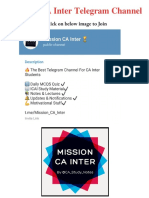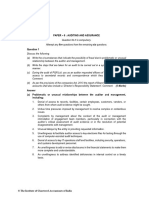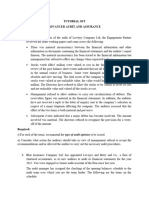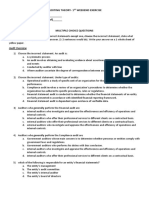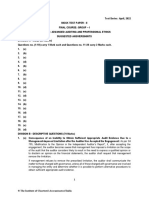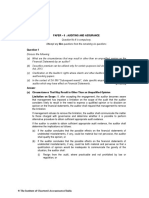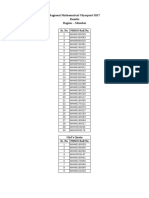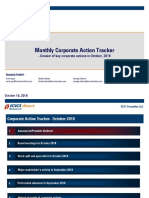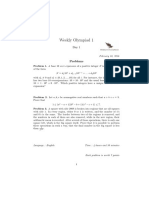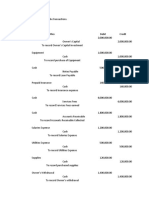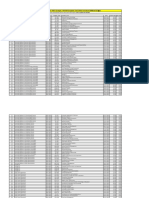Paper - 6: Auditing and Assurance: © The Institute of Chartered Accountants of India
Paper - 6: Auditing and Assurance: © The Institute of Chartered Accountants of India
Uploaded by
MuraliCopyright:
Available Formats
Paper - 6: Auditing and Assurance: © The Institute of Chartered Accountants of India
Paper - 6: Auditing and Assurance: © The Institute of Chartered Accountants of India
Uploaded by
MuraliOriginal Description:
Original Title
Copyright
Available Formats
Share this document
Did you find this document useful?
Is this content inappropriate?
Copyright:
Available Formats
Paper - 6: Auditing and Assurance: © The Institute of Chartered Accountants of India
Paper - 6: Auditing and Assurance: © The Institute of Chartered Accountants of India
Uploaded by
MuraliCopyright:
Available Formats
PAPER – 6 : AUDITING AND ASSURANCE
Question No.1 is compulsory.
Attempt any four questions from the remaining five questions.
Question 1
Examine with reasons (in short) whether the following statements are correct or incorrect:
(a) Few members of the Board of Directors oppose the appointment of Mr. N, an employee of
the company, as an Internal Auditor, stating that Mr. N is not a chartered accountant and
further he is an employee of the company.
(b) An Auditor is considered to lack independence if the partner of the audit firm deals with
shares and securities of the audited entity.
(c) The Audit Engagement documentations should ordinarily be retained by the auditor for
minimum of six years from the date of the auditor's report or the date of the group auditor's
report, whichever is later.
(d) Inquiry alone is sufficient to test the operating effectiveness of controls.
(e) During the audit process, the Auditor can easily identify all mistakes or manipulations that
may exist in the accounts through routine checking processes.
(f) PQR & Co., Chartered Accountants, resigned from the audit of a Government Company
and filed the resignation with the company and the registrar within 30 days. Comment,
whether PQR & Co. has complied with the provisions of the Companies Act, 2013.
(g) K Ltd., a non-government company, was incorporated on 01-10-2017. Mr. B, Managing
Director of K Ltd., himself appointed the first auditor of the company on 31-12-2017.
(h) The statutory auditor of ABC Ltd. is of the opinion that communicating key audit matters in
the auditor's report constitutes a substitute for disclosure in the financial statements.
(i) When statistical sampling is used to select a sample, sample need not be representative
because the statistical sampling takes care of the representation.
(j) Mr. A is a statutory auditor of ABC Ltd. The branch of ABC Ltd. is audited by Mr. B, another
Chartered Accountant. Mr. A requests for the photocopies of the audit documentation of
Mr. B pertaining to the branch audit. (2 x 10 = 20 Marks)
Answer
(a) Incorrect: As per section 138, the internal auditor shall either be a chartered accountant
or a cost accountant (whether engaged in practice or not), or such other professional as
may be decided by the Board to conduct internal audit of the functions and activities of the
companies. The internal auditor may or may not be an employee of the company.
(b) Correct: As per section 141 (3)(d), a person shall not be eligible for appointment as an
auditor of a company namely- a person, or his relative or partner is holding any security of
© The Institute of Chartered Accountants of India
2 INTERMEDIATE (NEW) EXAMINATION: MAY, 2018
or interest in the company or its subsidiary, or of its holding or associate company or a
subsidiary of such holding company. From the above it can be concluded that if the partner
deals with shares and securities of the audited entity, he would be lacking independence,
hence, disqualified to be appointed as an auditor.
Further, the Code of Ethics for Professional Accountants, prepared by the International
Federation of Accountants (IFAC) identifies five types of threats and if partner of the firm deals
with shares and securities of the audited firm then such threat is known as the Advocacy
Threats and auditor will be lacking independence.
(c) Incorrect: SQC 1 requires firms to establish policies and procedures for the retention of
engagement documentation. The retention period for audit engagements ordinarily is no
shorter than seven years from the date of the auditor’s report, or, if later, the date of the
group auditor’s report.
(d) Incorrect: Inquiry along with other audit procedures (for example observation, inspection,
external confirmation etc.) would only enable the auditor to test the operating effectiveness
of controls. Inquiry alone is not sufficient to test the operating effectiveness of controls.
(e) Incorrect: Routine checking cannot be depended upon to disclose all the mistakes or
manipulation that may exist in accounts. Certain other procedures also have to be applied
like trend and ratio analysis including review of internal control.
(f) Incorrect: As per section 140(2) the auditor who has resigned from the company shall
file within a period of 30 days from the date of resignation, a statement in the prescribed
Form with the company and the Registrar, and in case of the companies referred to in
section 139(5) i.e. Government company, the auditor shall also file such statement with
the Comptroller and Auditor-General of India, indicating the reasons and other facts as
may be relevant with regard to his resignation. In this case, the PQR & Co., was also
required to file prescribed Form with C & AG of India but it did not file the same. Therefore,
it did not comply with the provisions of the Companies Act, 2013.
(g) Incorrect: Section 139(6) of the Companies Act, 2013 lays down that the first auditor of a
company shall be appointed by the Board of Directors within 30 days from the date of
registration of the company. In view of the above, the appointment of first auditor made by
the managing director is in violation of the provisions of the Companies Act, 2013
(h) Incorrect: Communicating key audit matters in the auditor’s report is not a substitute for
disclosures in the financial statements that the applicable Financial reporting framework
requires management to make, or that are otherwise necessary to achieve fair
presentation.
(i) Incorrect: Whatever may be the approach non-statistical or statistical sampling, the
sample must be representative. This means that it must be closely similar to the whole
population although not necessarily exactly the same. The sample must be large enough
to provide statistically meaningful results.
© The Institute of Chartered Accountants of India
PAPER – 6: AUDITING AND ASSURANCE 3
(j) Incorrect: SA 230 issued by ICAI on Audit Documentation, and “Standard on Quality
Control (SQC) 1, provides that, unless otherwise specified by law or regulation, audit
documentation is the property of the auditor. He may at his discretion, make portions of,
or extracts from, audit documentation available to clients, provided such disclosure does
not undermine the validity of the work performed, or, in the case of assurance
engagements, the independence of the auditor or of his personnel.
Question 2
Discuss the following:
(a) Name the assertions for the following audit procedures:
(i) Year end inventory verification.
(ii) Depreciation has been properly charged on all assets.
(iii) The title deeds of the lands disclosed in the Balance Sheet are held in the name of
the company.
(iv) All liabilities are properly recorded in the financial statements.
(v) Related party transactions are shown properly. (5 Marks)
(b) Expenses which are essentially of a revenue nature if incurred for creating an asset or
adding to its value for achieving higher productivity are regarded as expenses of a capital
nature. Describe any five such expenses. (5 Marks)
(c) Principal aspects to be considered by an auditor while conducting an audit of final
statements of accounts. (5 Marks)
(d) List any five points that an auditor should consider to obtain an understanding of the
Company's automated environment. (5 Marks)
Answer
(a) (i) Year end inventory verification: Existence Assertion.
(ii) Depreciation has been properly charged on all assets: Valuation Assertion.
(iii) Title deed of lands disclosed in the Balance Sheet are held in the name of the
Company: Rights & Obligations Assertion.
(iv) All liabilities are properly recorded in the financial statements: Completeness.
(v) Related party transactions are shown properly: Presentation & Disclosure.
(b) Expenses which are essentially of a Revenue Nature, if incurred for creating an asset
or adding to its value for achieving higher productivity, are regarded as expenditure of a
capital nature. Examples of capital expenditure are-
(i) Material and wages- capital expenditure when expended on the construction of a
building or erection of machinery.
© The Institute of Chartered Accountants of India
4 INTERMEDIATE (NEW) EXAMINATION: MAY, 2018
(ii) Legal expenses- capital expenditure when incurred in connection with the purchase
of land or building.
(iii) Freight- capital expenditure when incurred in respect of purchase of plant and
machinery.
(iv) Repair- Major repairs of a fixed asset that increases its productivity.
(v) Wages- Wages paid on installation costs incurred in Plant & machinery.
(vi) Interest- Interest paid for the qualification period as per AS-16 i.e. before the asset is
constructed.
Whenever, therefore, a part of the expenditure, ostensibly of a revenue nature, is
capitalised it is the duty of the auditor not only to examine the precise particulars of the
expenditure but also the considerations on which it has been capitalised.
(c) Aspects to be covered in an audit: The principal aspects to be covered in an audit
concerning final statements of account are the following:
(i) An examination of the system of accounting and internal control to ascertain
whether it is appropriate for the business and helps in properly recording all
transactions.
(ii) Reviewing the system and procedures to find out whether they are adequate and
comprehensive and incidentally whether material inadequacies and weaknesses exist
to allow frauds and errors going unnoticed.
(iii) Checking of the arithmetical accuracy of the books of account by the verification
of postings, balances, etc.
(iv) Verification of the authenticity and validity of transaction entered into by making
an examination of the entries in the books of accounts with the relevant supporting
documents.
(v) Ascertaining that a proper distinction has been made between items of capital
and of revenue nature and that the amounts of various items of income and
expenditure adjusted in the accounts corresponding to the accounting period.
(vi) Comparison of the balance sheet and profit and loss account or other
statements with the underlying record in order to see that they are in accordance
therewith.
(vii) Verification of the title, existence and value of the assets appearing in the balance
sheet.
(viii) Verification of the liabilities stated in the balance sheet.
(ix) Checking the result shown by the profit and loss and to see whether the results
shown are true and fair.
© The Institute of Chartered Accountants of India
PAPER – 6: AUDITING AND ASSURANCE 5
(x) Where audit is of a corporate body, confirming that the statutory requirements
have been complied with.
(xi) Reporting to the appropriate person/body whether the statements of account
examined do reveal a true and fair view of the state of affairs and of the profit and
loss of the organisation.
(d) Understanding of the Company’s Automated Environment: Given below are some of
the points that an auditor should consider to obtain an understanding of the company’s
automated environment
• Information systems being used (one or more application systems and what they are)
• their purpose (financial and non-financial)
• Location of IT systems - local vs global
• Architecture (desktop based, client-server, web application, cloud based)
• Version (functions and risks could vary in different versions of same application)
• Interfaces within systems (in case multiple systems exist)
• In-house vs Packaged
• Outsourced activities (IT maintenance and support)
• Key persons (CIO, CISO, Administrators)
Question 3
(a) What constitutes a 'true and fair' view, is the matter of an auditor's judgement in the
particular circumstances of a case. In order to ensure 'true and fair' view, auditor has to
review certain points. Mention any such 5 (five) points in brief. (5 Marks)
(b) Mention any five attributes to be considered by an auditor while verifying for a depreciation
and amortisation expenses. (5 Marks)
(c) As statutory auditor of the company, list out audit procedures required to be undertaken
for the following:
(i) Interest income from fixed deposits. (4 Marks)
(ii) Dividend income. (2 Marks)
(iii) Gain/(loss) on sale of investment in Mutual funds. (2 Marks)
Also indicate disclosure requirements of above as per Companies Act, 2013. (2 Marks)
Answer
(a) True and Fair View: To ensure true and fair view, an auditor has to see:
(i) that the assets are neither undervalued or overvalued, according to the applicable
accounting principles,
© The Institute of Chartered Accountants of India
6 INTERMEDIATE (NEW) EXAMINATION: MAY, 2018
(ii) no material asset is omitted;
(iii) the charge, if any, on assets are disclosed;
(iv) material liabilities should not be omitted;
(v) the profit and loss account and balance sheet discloses all the matters required to be
disclosed;
(vi) accounting policies have been followed consistently; and
(vii) all unusual, exceptional or non-recurring items have been disclosed separately.
(b) Depreciation and Amortisation Expenses: Auditor needs to consider the following
attributes while verifying for depreciation and amortisation expenses:
• Obtain the understanding of entity’s accounting policy related to depreciation and
amortisation.
• Ensure that the Company’s policy for charging depreciation and amortisation is as per the
relevant provisions of Companies Act and applicable accounting standards.
• Whether the depreciation has been calculated after making adjustment of residual value
from the cost of the assets.
• Whether depreciation and amortisation charges are valid.
• Whether depreciation and amortisation charges are accurately calculated and recorded.
• Whether all depreciation and amortisation charges are recorded in the appropriate period.
• Ensure the parts (components) of each item of property, plant and equipment that are to
be depreciated separately has been properly identified.
• Whether the most appropriate depreciation method for each separately depreciable
component has been used.
(c) (i) For verifying interest income on fixed deposits:
• Obtain a listing of fixed deposits opened during the period under audit along with the
applicable interest rate and the number of days for which the deposit was
outstanding during the period. Verify the arithmetical accuracy of the interest
calculation made by the entity by multiplying the deposit amount with the applicable
rate and number of days during the period under audit.
• For deposits still outstanding as at the period- end, trace the same to the direct
confirmation obtained from the respective bank/ financial institution.
• Obtain a confirmation of interest income from the bank and verify that the interest
income as per bank reconciles to the calculation shared by the entity.
• Also, obtain a copy of Form 26AS (TDS withholding by the bank/ financial institution)
and reconcile the interest reflected therein to the calculation shared by client.
© The Institute of Chartered Accountants of India
PAPER – 6: AUDITING AND ASSURANCE 7
(ii) Dividend Income: For Dividends, verify that the same are recognised in the
statement of profit and loss only when the entity’s right to receive payment of the
dividend is established, provided it is probable that the economic benefits associated
with the dividend will flow to the entity and the amount of the dividend can be
measured reliably.
(iii) Gain/(loss) on sale of investment in mutual funds: Verify that Gain/(loss) on sale
of investment in mutual funds is recorded as other income only on transfer of title
from the entity and is determined as the difference between the redemption price and
carrying value of the investments. For the purpose, obtain the mutual fund statement
and trace the gain / loss as recorded in the books of account to the gain/ loss as
reflected in the statement.
Disclosure Requirements: Ensure whether the following disclosures as required under
Ind AS compliant Schedule III to Companies Act, 2013 have been made:
Whether ‘other income’’ has been classified as:
o Interest income
o Dividend income
o Other non-operating income (net of expenses directly attributable to such income)
Question 4
(a) M & Co. was appointed as auditor of IGI Ltd.. As an auditor what are the factors that would
be considered in the development of overall audit plan? (5 Marks)
(b) State the matters to be included in the auditor's report as per CARO, 2016, regarding:
(i) Private Placement of Preferential Issues. (2 Marks)
(ii) Utilisation of IPO and further public offer. (2 Marks)
(c) Briefly discuss the limitations of Internal Control. (6 Marks)
(d) Discuss the techniques available as Substantive Analytical Procedures. (5 Marks)
Answer
(a) Development of an Overall Plan: The auditor should consider the following matters in
developing his overall plan for the expected scope and conduct of the audit -
➢ The terms of his engagement and any statutory responsibilities.
➢ The nature and timing of reports or other communication.
➢ The applicable legal or statutory requirements.
➢ The accounting policies adopted by the client and changes in those policies.
➢ The effect of new accounting or auditing pronouncements on the audit.
➢ The identification of significant audit areas.
© The Institute of Chartered Accountants of India
8 INTERMEDIATE (NEW) EXAMINATION: MAY, 2018
➢ The setting of materiality levels for audit purposes.
➢ Conditions requiring special attention, such as the possibility of material error or fraud
or the involvement of parties in whom directors or persons who are substantial owners
of the entity are interested and with whom transactions are likely.
➢ The degree of reliance he expects to be able to place on accounting system and
internal control.
➢ Possible rotation of emphasis on specific audit areas.
➢ The nature and extent of audit evidence to be obtained.
➢ The work of internal auditors and the extent of their involvement, if any, in the audit.
➢ The involvement of other auditors in the audit of subsidiaries or branches of the client.
➢ The involvement of experts.
➢ The allocation of work to be undertaken between joint auditors and the procedures
for its control and review.
➢ Establishing and coordinating staffing requirements.
(b) (i) The auditor is required to report as per clause xiv of paragraph 3 of CARO 2016,
whether the company has made any preferential allotment or private placement of
shares or fully or partly convertible debentures during the year under review and if
so, as to whether the requirement of section 42 of the Companies Act, 2013 have
been complied with and the amount raised have been used for the purposes for which
the funds were raised. If not, provide the details in respect of the amount involved
and nature of non-compliance;
(ii) It is duty of the auditor to report as per clause ix of paragraph 3 of CARO 2016,
whether moneys raised by way of initial public offer or further public offer (including
debt instruments) and term loans were applied for the purposes for which those are
raised. If not, the details together with delays or default and subsequent rectification,
if any, as may be applicable, be reported.
(c) Limitations of Internal Control:
(i) Internal control can provide only reasonable assurance: Internal control, no
matter how effective, can provide an entity with only reasonable assurance about
achieving the entity’s financial reporting objectives. The likelihood of their
achievement is affected by inherent limitations of internal control.
(ii) Human judgment in decision-making: Realities that human judgment in decision-
making can be faulty and that breakdowns in internal control can occur because of
human error.
(iii) Lack of understanding the purpose: Equally, the operation of a control may not be
effective, such as where information produced for the purposes of internal control (for
© The Institute of Chartered Accountants of India
PAPER – 6: AUDITING AND ASSURANCE 9
example, an exception report) is not effectively used because the individual
responsible for reviewing the information does not understand its purpose or fails to
take appropriate action.
(iv) Collusion among People: Additionally, controls can be circumvented by the
collusion of two or more people or inappropriate management override of internal
control. For example, management may enter into side agreements with customers
that alter the terms and conditions of the entity’s standard sales contracts, which may
result in improper revenue recognition. Also, edit checks in a software program that
are designed to identify and report transactions that exceed specified credit limits
may be overridden or disabled.
(v) Judgements by Management: Further, in designing and implementing controls,
management may make judgments on the nature and extent of the controls it chooses
to implement, and the nature and extent of the risks it chooses to assume.
(vi) Limitations in case of Small Entities: Smaller entities often have fewer
employees due to which segregation of duties is not practicable. However, in a small
owner-managed entity, the owner-manager may be able to exercise more effective
oversight than in a larger entity. This oversight may compensate for the generally
more limited opportunities for segregation of duties.
On the other hand, the owner-manager may be more able to override controls
because the system of internal control is less structured. This is taken into account
by the auditor when identifying the risks of material misstatement due to fraud.
(d) Techniques available as Substantive Analytical Procedures : The design of a
substantive analytical procedure is limited only by the availability of reliable data and the
experience and creativity of the audit team. Substantive analytical procedures generally
take one of the following forms:
Trend analysis — A commonly used technique is the comparison of current data with the
prior period balance or with a trend in two or more prior period balances. We evaluate
whether the current balance of an account moves in line with the trend established with
previous balances for that account, or based on an understanding of factors that may cause
the account to change.
Ratio analysis — Ratio analysis is useful for analysing asset and liability accounts as well
as revenue and expense accounts. An individual balance sheet account is difficult to
predict on its own, but its relationship to another account is often more predictable (e.g.,
the trade receivables balance related to sales). Ratios can also be compared over time or
to the ratios of separate entities within the group, or with the ratios of other companies in
the same industry.
Reasonableness tests — Unlike trend analysis, this analytical procedure does not rely on
events of prior periods, but upon non-financial data for the audit period under consideration
(e.g., occupancy rates to estimate rental income or interest rates to estimate interest
© The Institute of Chartered Accountants of India
10 INTERMEDIATE (NEW) EXAMINATION: MAY, 2018
income or expense). These tests are generally more applicable to income statement
accounts and certain accrual or prepayment accounts.
Structural modelling — A modelling tool constructs a statistical model from financial
and/or non-financial data of prior accounting periods to predict current account balances
(e.g., linear regression).
Question 5
(a) Define Emphasis of Matter Paragraph and how it should be disclosed in the Independent
Auditor's Report? (5 Marks)
(b) At the AGM of HDB Pvt. Ltd., Mr. R was appointed as the statutory auditor. He, however,
resigned after 3 months since he wanted to pursue his career in banking sector. The Board
of Director has appointed Mr. L as the statutory auditor in board meeting within 30 days.
Comment on the matter with reference to the provisions of Companies Act, 2013.
(5 Marks)
(c) XYZ & Associates, Chartered Accountants, while evaluating the operating effectiveness
of internal controls, detects deviation from controls. In such a situation, state the specific
inquiries to be made by an auditor to understand these matters and their potential
consequences. (5 Marks)
(d) Mr. A is appointed as statutory auditor of a company for the Financial Year ended
31st March, 2018. During the course of audit, it was found that few doubtful transactions
had been committed by finance manager who retired in March, 2018. The fraud was going
on since last 2-3 years and the total amount misappropriated exceeding ` 100 lakhs. As a
statutory auditor, what would be reporting responsibilities of Mr. A? (5 Marks)
Answer
(a) Emphasis of Matter paragraph: A paragraph included in the auditor’s report that refers
to a matter appropriately presented or disclosed in the financial statements that, in the
auditor’s judgment, is of such importance that it is fundamental to users’ understanding of
the financial statements.
When the auditor includes an Emphasis of Matter paragraph in the auditor’s report,
the auditor shall:
(i) Include the paragraph within a separate section of the auditor’s report with an
appropriate heading that includes the term “Emphasis of Matter”;
(ii) Include in the paragraph a clear reference to the matter being emphasized and to
where relevant disclosures that fully describe the matter can be found in the financial
statements. The paragraph shall refer only to information presented or disclosed in
the financial statements; and
(iii) Indicate that the auditor’s opinion is not modified in respect of the matter emphasized.
© The Institute of Chartered Accountants of India
PAPER – 6: AUDITING AND ASSURANCE 11
(b) Casual Vacancy by Resignation: As per Section 139(8), any casual vacancy in the
office of an auditor shall in the case of a company other than a company whose accounts
are subject to audit by an auditor appointed by the Comptroller and Auditor-General of
India, be filled by the Board of Directors within 30 days. If such casual vacancy is as a
result of the resignation of an auditor, such appointment shall also be approved by the
company at a general meeting convened within three months of the recommendation of
the Board and he shall hold the office till the conclusion of the next annual general meeting.
Further, as per section 140(2) the auditor who has resigned from the company shall file
within a period of 30 days from the date of resignation, a statement in the prescribed Form
with the company and the Registrar. In the instant case, R resigned after three months of
his appointment as statutory auditor as he wanted to pursue his career in banking sector.
Therefore, the board of director has appointed Mr. L as the statutory auditor with in 30
days is in order subject to such appointment shall also be approved by the company at a
general meeting convened within three months of the recommendation of the Board .
Further, it is also the duty of the auditor to file, within a period of 30 days from the date of
resignation, a statement in the prescribed Form with the company and the Registrar in
compliance with section 140(2) of the Companies Act, 2013.
(c) Evaluating the Operating Effectiveness of Controls: When evaluating the operating
effectiveness of relevant controls, the auditor shall evaluate whether misstatements that
have been detected by substantive procedures indicate that controls are not operating
effectively. The absence of misstatements detected by substantive procedures, however,
does not provide audit evidence that controls related to the assertion being tested are
effective.
When deviations from controls upon which the auditor intends to rely are detected, the
auditor shall make specific inquiries to understand these matters and their potential
consequences, and shall determine whether:
(a) The tests of controls that have been performed provide an appropriate basis for
reliance on the controls;
(b) Additional tests of controls are necessary; or
(c) The potential risks of misstatement need to be addressed using substantive
procedures.
A material misstatement detected by the auditor’s procedures is a strong indicator of the
existence of a significant deficiency in internal control.
(d) Reporting to the Central Government- As per section 143(12) of the Companies Act,
2013 read with Rule 13 of the Companies (Audit and Auditors) Rules, 2014, if an auditor
of a company in the course of the performance of his duties as auditor, has reaso n to
believe that an offence of fraud, which involves or is expected to involve individually an
amount of ` 1 crore or above, is being or has been committed in the company by its officers
© The Institute of Chartered Accountants of India
12 INTERMEDIATE (NEW) EXAMINATION: MAY, 2018
or employees, the auditor shall report the matter to the Central Gov ernment within such
time and in such manner as prescribed.
The manner of reporting the matter to the Central Government is as follows:
(1) the auditor shall report the matter to the Board or the Audit Committee, as the case
may be, immediately but not later than 2 days of his knowledge of the fraud, seeking
their reply or observations within 45 days;
(2) on receipt of such reply or observations, the auditor shall forward his report and the
reply or observations of the Board or the Audit Committee along with his comments
(on such reply or observations of the Board or the Audit Committee) to the Central
Government within 15 days from the date of receipt of such reply or observations;
(3) in case the auditor fails to get any reply or observations from the Board or the Audit
Committee within the stipulated period of 45 days, he shall forward his report to the
Central Government along with a note containing the details of his report that was
earlier forwarded to the Board or the Audit Committee for which he has not received
any reply or observations;
(4) the report shall be sent to the Secretary, Ministry of Corporate Affairs in a sealed
cover by Registered Post with Acknowledgement Due or by Speed Post followed by
an e-mail in confirmation of the same;
(5) the report shall be on the letter-head of the auditor containing postal address, e-mail
address and contact telephone number or mobile number and be signed by the
auditor with his seal and shall indicate his Membership Number; and
(6) the report shall be in the form of a statement as specified in Form ADT-4.
The auditor is also required to report under clause (x) of paragraph 3 of Companies
(Auditor’s Report) Order, 2016 [CARO, 2016], whether any fraud by the company or any
fraud on the Company by its officers or employees has been noticed or reported during the
year. If yes, the nature and the amount involved is to be indicated.
Question 6
Answer any four:
(a) M/s. ABC & Co. is an Audit firm, having partners CA. A, CA. B and CA. C. The firm has
been offered the appointment as an Auditor of XYZ Ltd. for the Financial Year 2017-18.
Mr. D, the relative of CA. A, is holding 25,000 shares (face value of ` 10 each) in XYZ Ltd.
having market value of ` 90,000. Are M/s. ABC & Co. qualified to be appointed as Auditors
of XYZ Ltd.? (5 Marks)
(b) Mr. M, has served as an auditor in the Co-Operative Department of a Government, is
appointed as a statutory auditor by a Co-Operative Society that has receipts over ` 3
crores during the financial year. He is not a Chartered Accountant. Mr. D, Chartered
Accountant is appointed to conduct tax audit of the society under section 44AB of the
Income Tax Act, 1961. Comment. (5 Marks)
© The Institute of Chartered Accountants of India
PAPER – 6: AUDITING AND ASSURANCE 13
(c) Mr. A approaches a bank for financial assistance for his upcoming project. The Bank
Branch Manager, after verifying the proposal, is agreeable to financing Mr. A, but asks for
the security to be offered to the bank. Discuss the nature of securities required to be offered
to the bank. (5 Marks)
(d) State the objectives of audit of Local Bodies. (5 Marks)
(e) The auditor should understand and consider the risks that may arise from the use of
Information Technology (IT) Systems. (5 Marks)
Answer
(a) As per section 141(3)(d)(i), a person shall not be eligible for appointment as an auditor of
a company, who, or his relative or partner is holding any security of or interest in the
company or its subsidiary, or of its holding or associate company or a subsidiary of such
holding company. However, as per proviso to this section, the relative of the person may
hold the securities or interest in the company of face value not exceeding of ` 1,00,000.
In the instant case, M/s ABC & Co. is an audit firm having partners CA. A, CA. B and CA.
C. Mr. D is a relative of CA. A and he is holding shares in XYZ Ltd. of face value of
` 2,50,000 (25,000 shares x rupees 10 per share). Market value of ` 90,000 would not be
relevant.
Therefore, M/s ABC & Co. is disqualified for appointment as an auditors of XYZ Ltd. as
the relative of CA. A (i.e. partner of M/s ABC & Co.) is holding the securities in XYZ Ltd.
which is exceeding the limit mentioned in proviso to section 141(3)(d)(i) of the Companies
Act, 2013.
(b) Qualifications and Appointment of Auditors - Apart from a chartered accountant within
the meaning of the Chartered Accountants Act, 1949, some of the State Co-operative Acts
have permitted persons holding a government diploma in co-operative accounts or in co-
operation and accountancy and also a person who has served as an auditor in the co-
operative department of a government to act as an auditor.
An auditor of a co-operative society is appointed by the Registrar of Co-operative Societies
and the auditor so appointed conducts the audit on behalf of the Registrar and submits his
report to him as also to the society.
Thus, in view of above provisions, appointment of Mr. M as statutory auditor and Mr. D as
tax auditor under Section 44 AB is in order.
(c) Nature of Security:
I. Primary security refers to the security offered by the borrower for bank finance or
the one against which credit has been extended by the bank. This security is the
principal security for an advance.
II. Collateral security is an additional security. Security can be in any form i.e. tangible
or intangible asset, movable or immovable asset.
© The Institute of Chartered Accountants of India
14 INTERMEDIATE (NEW) EXAMINATION: MAY, 2018
Examples of most common types of securities accepted by banks are the following.
• Personal Security of Guarantor
• Goods / Stocks / Debtors / Trade Receivables
• Gold Ornaments and Bullion
• Immovable Property
• Plantations (For Agricultural Advances)
• Third Party Guarantees
• Banker’s General Lien
• Life Insurance Policies
• Stock Exchange Securities and Other Instruments
(d) Objective of Audit of Local Bodies: The external control of municipal expenditure is
exercised by the state governments through the appointment of auditors to examine
municipal accounts. The municipal corporations of Delhi, Mumbai and a few others have
powers to appoint their own auditors for regular external audit. The important objectives of
audit are:
(i) reporting on the fairness of the content and presentation of financial statements;
(ii) reporting upon the strengths and weaknesses of systems of financial control;
(iii) reporting on the adherence to legal and/or administrative requirements;
(iv) reporting upon whether value is being fully received on money spent; and
(v) detection and prevention of error, fraud and misuse of resources.
(e) Having obtained an understanding of the IT systems and the automated environment of a
company, the auditor should now understand the risks that arise from the use of IT
systems.
Given below are some such risks that should be considered,
• Inaccurate processing of data, processing inaccurate data, or both
• Unauthorized access to data
• Direct data changes (backend changes)
• Excessive access / Privileged access (super users)
• Lack of adequate segregation of duties
• Unauthorized changes to systems or programs
• Failure to make necessary changes to systems or programs
• Loss of data
© The Institute of Chartered Accountants of India
You might also like
- 001 Government AccountingDocument75 pages001 Government AccountingMark Brian Parantar100% (1)
- 1519744310723nature Objective and Scope of AuditDocument8 pages1519744310723nature Objective and Scope of AuditAnkur KunduNo ratings yet
- IfrsDocument20 pagesIfrsarchana_anuragi100% (3)
- Financial Statements and Cash Flow: Mcgraw-Hill/IrwinDocument37 pagesFinancial Statements and Cash Flow: Mcgraw-Hill/IrwinSeyha HanNo ratings yet
- P6 Audit New Suggested CA Inter May 18Document14 pagesP6 Audit New Suggested CA Inter May 18Rishabh jainNo ratings yet
- Dec 2021Document16 pagesDec 2021DiyaNo ratings yet
- Audit Dec 21 Suggested Answer @mission - CA - InterDocument19 pagesAudit Dec 21 Suggested Answer @mission - CA - Intersantosh pandeyNo ratings yet
- Correct and Incorred Inter May 23 AuditDocument36 pagesCorrect and Incorred Inter May 23 Audittholkappiyanjk14No ratings yet
- Audit Suggested May2019-Ipc-P6Document13 pagesAudit Suggested May2019-Ipc-P6Neeraj OjhaNo ratings yet
- 73259bos559103 Inter p6Document15 pages73259bos559103 Inter p6Priyansh KhatriNo ratings yet
- 6) AuditDocument16 pages6) AuditKrushna MateNo ratings yet
- Test Series: August, 2018 Mock Test Paper - 1 Intermediate Group - Ii Paper - 6: Auditing and AssuranceDocument3 pagesTest Series: August, 2018 Mock Test Paper - 1 Intermediate Group - Ii Paper - 6: Auditing and Assurancesahil kumarNo ratings yet
- Paper - 2: Auditing and AssuranceDocument10 pagesPaper - 2: Auditing and AssuranceManas Kumar SahooNo ratings yet
- Paper - 2: Auditing and Assurance QuestionsDocument20 pagesPaper - 2: Auditing and Assurance Questions9331934775100% (1)
- CA Inter Paper 6 All Question PapersDocument116 pagesCA Inter Paper 6 All Question PapersNivedita SharmaNo ratings yet
- Bos 36238 P 6Document16 pagesBos 36238 P 6vinay parulekarNo ratings yet
- Audit Suggested Nov2019-Ipc-P6Document12 pagesAudit Suggested Nov2019-Ipc-P6Neeraj OjhaNo ratings yet
- IPCC - Auditing - RTP Nov 2009Document23 pagesIPCC - Auditing - RTP Nov 2009Omnia HassanNo ratings yet
- AuditNew Suggested Ans CA Inter Jan 21Document14 pagesAuditNew Suggested Ans CA Inter Jan 21Priyansh KhatriNo ratings yet
- Auditing PaperDocument172 pagesAuditing PaperHimanshu SainiNo ratings yet
- © The Institute of Chartered Accountants of IndiaDocument6 pages© The Institute of Chartered Accountants of Indialuckyjagadesh0No ratings yet
- Term Test 1Document3 pagesTerm Test 1Hassan TanveerNo ratings yet
- 55067bos44235p6 Iipc ADocument10 pages55067bos44235p6 Iipc AAshutosh KumarNo ratings yet
- PCC - Auditing - RTP - June 2009Document18 pagesPCC - Auditing - RTP - June 2009Omnia HassanNo ratings yet
- Paper - 3: Advanced Auditing and Professional Ethics: (5 Marks)Document16 pagesPaper - 3: Advanced Auditing and Professional Ethics: (5 Marks)RashmiNo ratings yet
- Auditing and Assurance Block Revision Mock 1 (Merge)Document349 pagesAuditing and Assurance Block Revision Mock 1 (Merge)Pöþè'Dennis Köwrëäl DöwshNo ratings yet
- Audit Assurance 2.3 August 2022 PDFDocument19 pagesAudit Assurance 2.3 August 2022 PDFProf. OBESENo ratings yet
- Question No. 1 Is Compulsory. Attempt Any Five Questions From The RestDocument8 pagesQuestion No. 1 Is Compulsory. Attempt Any Five Questions From The RestNithyashree RajagopalanNo ratings yet
- Test Series: March, 2017 Mock Test Paper Intermediate (Ipc) Group - Ii Paper - 6: Auditing and AssuranceDocument2 pagesTest Series: March, 2017 Mock Test Paper Intermediate (Ipc) Group - Ii Paper - 6: Auditing and AssuranceVallabh MahajanNo ratings yet
- CA Inter Audit Suggested Answer May 2022Document18 pagesCA Inter Audit Suggested Answer May 2022Henry RobinsonNo ratings yet
- © The Institute of Chartered Accountants of IndiaDocument8 pages© The Institute of Chartered Accountants of Indiadeepika devsaniNo ratings yet
- Auditing: The Institute of Chartered Accountants of PakistanDocument3 pagesAuditing: The Institute of Chartered Accountants of PakistanadnanNo ratings yet
- MTP 10 21 Answers 1694676341Document9 pagesMTP 10 21 Answers 1694676341shoaibinamdar1454No ratings yet
- Ser. 3RD Audit A. KDocument10 pagesSer. 3RD Audit A. Kruhamahpopson111No ratings yet
- 2021 June Tutorial Set Questions - AuditDocument10 pages2021 June Tutorial Set Questions - AuditakpanyapNo ratings yet
- Auditing Set 2Document7 pagesAuditing Set 2cleophacerevivalNo ratings yet
- MTP m21 A Ans 2Document8 pagesMTP m21 A Ans 2sakshiNo ratings yet
- Audit Suggested Ans CA Inter Nov 20Document14 pagesAudit Suggested Ans CA Inter Nov 20Priyansh KhatriNo ratings yet
- CA Inter Audit Q MTP 2 May 23Document8 pagesCA Inter Audit Q MTP 2 May 23Sam KukrejaNo ratings yet
- Audit Test 2 QPDocument3 pagesAudit Test 2 QPApoorv JainNo ratings yet
- ICAG Paper 3 - Advance AuditingDocument57 pagesICAG Paper 3 - Advance AuditingScott MensahNo ratings yet
- All Mcqs Are Compulsory Question No. 1 Is Compulsory. Attempt Any Four Questions From The RestDocument12 pagesAll Mcqs Are Compulsory Question No. 1 Is Compulsory. Attempt Any Four Questions From The RestGJ ELASHREEVALLINo ratings yet
- Inter Audit - SubjectiveDocument4 pagesInter Audit - SubjectiveYogesh BansalNo ratings yet
- Advanced Auditing and Professional Ethics - QDocument16 pagesAdvanced Auditing and Professional Ethics - QCAtestseriesNo ratings yet
- CA Inter Audit Suggested Answer May 2024 Exam Castudynotes ComDocument21 pagesCA Inter Audit Suggested Answer May 2024 Exam Castudynotes Comchaurasiaakshat26No ratings yet
- Pe2 Auditing Nov05Document14 pagesPe2 Auditing Nov05api-3825774No ratings yet
- Mid Term Sir JH PDFDocument4 pagesMid Term Sir JH PDFMuhammad YahyaNo ratings yet
- 8int 2006 Jun QDocument4 pages8int 2006 Jun Qapi-19836745No ratings yet
- Auditing Theory-1 Weekend Exercise NAME: - PROFESSOR: - (Acctg12 Prof)Document3 pagesAuditing Theory-1 Weekend Exercise NAME: - PROFESSOR: - (Acctg12 Prof)ezraelydanNo ratings yet
- Auditing & Assurance (June-2009)Document12 pagesAuditing & Assurance (June-2009)P VenkatesanNo ratings yet
- Auditing - AnswersDocument9 pagesAuditing - Answerspriyanshagrawal907No ratings yet
- © The Institute of Chartered Accountants of IndiaDocument11 pages© The Institute of Chartered Accountants of IndiaGJ ELASHREEVALLINo ratings yet
- Audit May 24 - MergedDocument167 pagesAudit May 24 - MergedVaram ReddyNo ratings yet
- Audit MTP 2 PDFDocument8 pagesAudit MTP 2 PDFAkshay JainNo ratings yet
- Attention C.A. PCC & Ipcc Students: (No.1 Institute of Jharkhand)Document9 pagesAttention C.A. PCC & Ipcc Students: (No.1 Institute of Jharkhand)Dharnis123No ratings yet
- AuditNew Nov18 Suggested Ans CA InterDocument15 pagesAuditNew Nov18 Suggested Ans CA InterRishabh jainNo ratings yet
- Advanced AuditingDocument14 pagesAdvanced Auditingpriyeshrjain1No ratings yet
- CA IPCC Auditing Suggested Answer Nov 2015Document12 pagesCA IPCC Auditing Suggested Answer Nov 2015Siva Narayana Phani MouliNo ratings yet
- Section B Questions and Answers. Each Question Carries 5 Marks 1. Distinguish Between Accounting and Auditing. (2012, 2013)Document8 pagesSection B Questions and Answers. Each Question Carries 5 Marks 1. Distinguish Between Accounting and Auditing. (2012, 2013)sadathnooriNo ratings yet
- Auditing QuestionDocument7 pagesAuditing QuestionWaqar AmjadNo ratings yet
- Aplication Level Audit Assurance Nov Dec 2013Document2 pagesAplication Level Audit Assurance Nov Dec 2013Noman_TufailNo ratings yet
- Audit and AssuranceDocument16 pagesAudit and AssuranceAmolaNo ratings yet
- Class Xii Second Preboard PaperDocument6 pagesClass Xii Second Preboard PaperMuraliNo ratings yet
- Solution of Triangle: Sine RuleDocument41 pagesSolution of Triangle: Sine RuleMuraliNo ratings yet
- Regional Mathematical Olympiad-2017 Results Region - Mumbai: Sr. No PRMO Roll NoDocument1 pageRegional Mathematical Olympiad-2017 Results Region - Mumbai: Sr. No PRMO Roll NoMuraliNo ratings yet
- Problem 5: - On Side AC of Circle of Point A Is Defined Similarly. Prove That ADocument1 pageProblem 5: - On Side AC of Circle of Point A Is Defined Similarly. Prove That AMuraliNo ratings yet
- Functional Equations: Olympiad CornerDocument6 pagesFunctional Equations: Olympiad CornerMuraliNo ratings yet
- 520386Document3 pages520386MuraliNo ratings yet
- 06 Audit in Automated EnvironmentDocument8 pages06 Audit in Automated EnvironmentMuraliNo ratings yet
- RMO 2010 Results Telangana PDFDocument3 pagesRMO 2010 Results Telangana PDFMuraliNo ratings yet
- Monthly Corporate Action Tracker: - Dossier of Key Corporate Actions in October, 2018Document20 pagesMonthly Corporate Action Tracker: - Dossier of Key Corporate Actions in October, 2018MuraliNo ratings yet
- Regional Coordinators 2018Document8 pagesRegional Coordinators 2018MuraliNo ratings yet
- Weekly Olympiad 1 PDFDocument1 pageWeekly Olympiad 1 PDFMuraliNo ratings yet
- The Pigeonhole Principle PDFDocument5 pagesThe Pigeonhole Principle PDFMurali100% (1)
- PS7 PDFDocument11 pagesPS7 PDFMuraliNo ratings yet
- Sample OMR Sheet Marking PDFDocument1 pageSample OMR Sheet Marking PDFMuraliNo ratings yet
- NMSF PRE RMO 2018 Registration Form PDFDocument2 pagesNMSF PRE RMO 2018 Registration Form PDFMuraliNo ratings yet
- Legal Aspect ReflectionDocument4 pagesLegal Aspect ReflectionKim Nicole ReyesNo ratings yet
- Reporting and Analyzing ReceivablesDocument72 pagesReporting and Analyzing ReceivablesRishabh JainNo ratings yet
- AE13 Final ActivityDocument5 pagesAE13 Final ActivityWenjunNo ratings yet
- Date Sheet For Final Exams For Main Campus, All Sub-Campuses and All Government Affiliated CollgesDocument29 pagesDate Sheet For Final Exams For Main Campus, All Sub-Campuses and All Government Affiliated Collgessalman 541No ratings yet
- Eb Kiesofinaccifrs2ed Chapter 01Document48 pagesEb Kiesofinaccifrs2ed Chapter 01CamyNo ratings yet
- Gilbert CompanyDocument15 pagesGilbert CompanyThricia Mae IgnacioNo ratings yet
- AccountingDocument14 pagesAccountingKleint Tadem OcialNo ratings yet
- Nomination Form: Commission On AuditDocument3 pagesNomination Form: Commission On AuditCarmela GonzalesNo ratings yet
- FABM1 Lesson2-1 Branches of AccountingDocument12 pagesFABM1 Lesson2-1 Branches of AccountingKassandra KayNo ratings yet
- Accounting For Management-1 Unit 3 Final Accounts of Sole ProprietorshipDocument33 pagesAccounting For Management-1 Unit 3 Final Accounts of Sole Proprietorshipkuldeeprathore612994No ratings yet
- BAFS - Mock Paper 2A - Set 10 - EngDocument9 pagesBAFS - Mock Paper 2A - Set 10 - Enghannahho0723No ratings yet
- Asad Hayat NiaziDocument2 pagesAsad Hayat NiaziM RaffiNo ratings yet
- Introduction To Audit and Audit Standard Setting ProcessDocument8 pagesIntroduction To Audit and Audit Standard Setting ProcessIrish SanchezNo ratings yet
- Act 202 SS1Document25 pagesAct 202 SS1estherNo ratings yet
- Term 2 Program 2024Document10 pagesTerm 2 Program 2024mezinesemeNo ratings yet
- PB SQP 12th ACC (SS) 2023-24Document14 pagesPB SQP 12th ACC (SS) 2023-24aanchal prasad100% (4)
- Errors and Corrections ProblemsDocument13 pagesErrors and Corrections ProblemsJoyluxxiNo ratings yet
- S Chand and Company LimitedDocument21 pagesS Chand and Company LimitedNishit GolchhaNo ratings yet
- BusCom Long Quiz Possible QuestionsDocument5 pagesBusCom Long Quiz Possible QuestionsCathleen Drew TuazonNo ratings yet
- Chap1 3 G4 BSMA3A Knowledge and Application of Management Accounting Practices On The Financial Performance of Bread and Pastries Manufacturing BusinessesDocument34 pagesChap1 3 G4 BSMA3A Knowledge and Application of Management Accounting Practices On The Financial Performance of Bread and Pastries Manufacturing BusinessesMa. Althea SierrasNo ratings yet
- Positive Accounting TheoryDocument6 pagesPositive Accounting TheoryAndi IrwanNo ratings yet
- Projected Cash Flow Statement in ExcelDocument19 pagesProjected Cash Flow Statement in ExcelfarshidianNo ratings yet
- Yashvika CVDocument1 pageYashvika CVAaron ferreiraNo ratings yet
- Guidance Note (Mat)Document6 pagesGuidance Note (Mat)Cma Saurabh AroraNo ratings yet
- Rulesofdebitandcredit 101029141535 Phpapp01Document85 pagesRulesofdebitandcredit 101029141535 Phpapp01Elyse CameroNo ratings yet
- Year Particulars PR Debit CreditDocument3 pagesYear Particulars PR Debit CreditJohn Lloyd SuizoNo ratings yet
- Financial Accounting Paper 1.1 July 2023Document20 pagesFinancial Accounting Paper 1.1 July 2023johny SahaNo ratings yet






